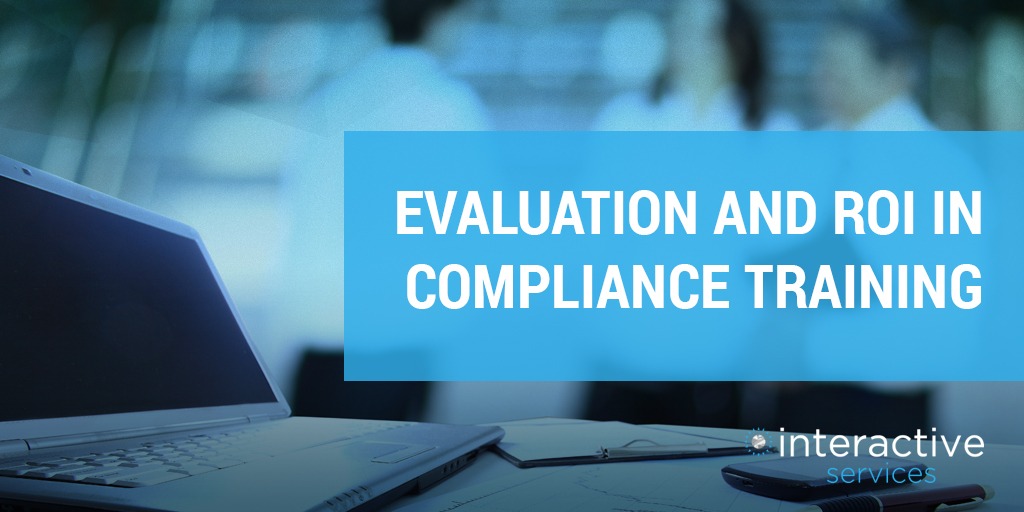
If your organization has what you believe to be a world-class compliance training initiative, then congratulations. The chances are your program includes some or all of the following:
- A focus on behavior change and employee conduct rather than just knowledge.
- Risk- and role-based scenarios to help employees understand the company’s ethical expectations.
- Reinforcement of ethical decision-making in relevant and realistic situations.
- Elements of micro-learning, collaborative learning, and comprehensive communication programs designed to reinforce critical lessons and ensure they stick.
But what about evaluation and return on investment (ROI)?
How have you planned to measure the effectiveness ROI of your initiative?
Evaluation and ROI are important indicators of how well a program is working and how much risk is mitigated. If these indicators aren’t measured, you may have a world-class program and not know it. Worse, you may have an underperforming program, one that puts the organization at risk of customer complaints, failing a compliance audit, generating bad publicity, or even receiving hefty penalties.
In our experience, up to one-half of organisations are unsure about the outcomes their training programs achieved. How can you ensure you are not one of them?
Measuring ROI
An accepted belief is that mature, well-run ethics and compliance programs result in higher performance and improved outcomes. And studies by the advocacy group, Trust Across America, indicate that integrity can be a major competitive advantage. Over three years America’s most trustworthy public companies outperformed the S&P 500. Companies that value transparency around ethics and compliance issues have increased profitability and have grown at a faster rate.
Higher integrity scores have been linked with cost-reductions, like less employee misconduct and improved risk identification and were linked to boosts in business performance, including higher employee productivity, better strategic management, and improved business performance.
Organizations that implement compliance training programs typically want to measure return on investment (ROI). But compliance training ROI can be hard to measure. Some organizations consider factors such as conduct issues, employee turnover, and employee productivity measures. Many also use qualitative indicators, such as talent recruitment, leadership trust, and employee engagement.
Compliance training that focuses on specific aspects of a regulation that employees encounter daily will help reduce training time, boost productivity, and reduce risk. Research has shown up to a 50 per cent reduction in training time in organizations that featured role-based compliance training. Incorporating this approach in their compliance programs reduces costs and leaders will see a significant impact on their ROI.
While ROI is an important metric, it shouldn’t be the sole focus of a comprehensive compliance training initiative. The best gauge of ROI might be employees who stick around. In other words, here’s the ROI you’re looking for:
productive employees who understand and are committed to the ethics and compliance standards of your company
and who engage in behaviors that support compliance.
When it comes to evaluating and determining the ROI of your compliance initiative, heed the advice of the popular business book written by John Doerr and measure what matters.
Evaluating Compliance Training Programs
One of the most challenging aspects of implementing a compliance training program is identifying how to measure effectiveness. It’s not enough that both managers and employees feel the program is beneficial. There must be measurable qualitative and quantitative outcomes. Some popular methods for evaluating compliance training programs include:
- Conducting pre- and post-training surveys.
- Gathering data from your compliance hotline.
- Measuring the number of breaches of the code-of-conduct.
- Analyzing internal audit findings.
- Conducting peer reviews and focus groups.
- Conducting exit interviews and employee surveys.
- Measuring employee performance around compliant behavior.
- Reviewing Learning Management System data.
Let’s look at that last one in more detail. Learning management systems (LMSs) can provide metrics and generate reports that give you data pointing to the effectiveness of training, like time spent on each module, assessment scores, number of times an assessment was attempted, and course completion rates. This information can provide insights. Low assessment scores, for example, could indicate that the content is not presented as effectively as it should be.
There are some widely-used evaluation models, including Kirkpatrick’s Four Levels of Evaluation, the Phillips ROI Methodology and Bersin’s Impact Measurement Framework that you might want to incorporate into your compliance training initiative.
No matter what approach you choose, you must evaluate your program on an ongoing basis using key risk areas. Good luck, and don’t forget… what matters gets measured.
We hope you found this guide useful. To see how we apply these principles to a comprehensive learning experience, take a free trial of our Integrity Ethics and Compliance Learning Library
